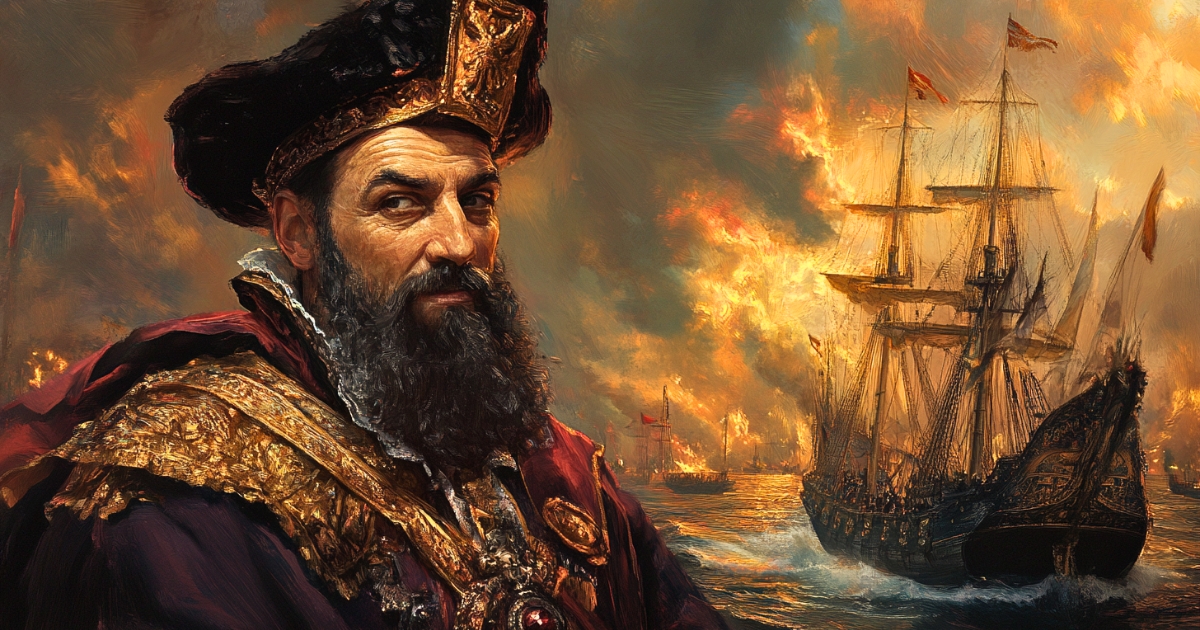In the early 16th century, at the height of the Age of Exploration, Portuguese-born explorer Ferdinand Magellan was about to achieve a historic feat. His fleet’s attempt at circumnavigating the globe would become a catalyst for significant advancements in navigation techniques and geographical knowledge of the time.
Magellan’s voyage revealed the true vastness of the Pacific Ocean, fundamentally altering the concept of world maps. It led to the discovery of the strait at the southern tip of South America (later named the Strait of Magellan) and pioneered new sea routes. Moreover, it greatly improved astronomical observation techniques and cartography for long voyages, bringing valuable information about unknown regions, their flora, fauna, and cultures, thus expanding European worldviews.
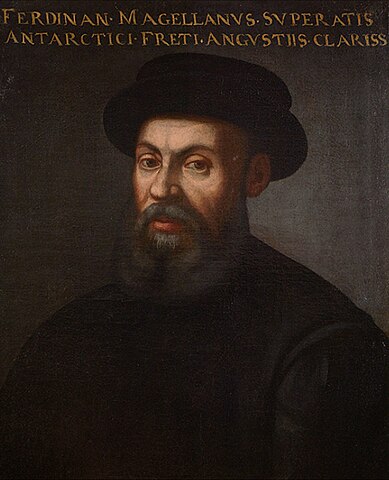
Ferdinand Magellan (c. 1480-1521). 16th-century explorer who led the first circumnavigation of the world. By The Mariner’s Museum Collection
This article explores the innovative navigation techniques and historical significance of this grand adventure, based on records of Magellan’s voyage, particularly the detailed logbook of Antonio Pigafetta.
- The Importance of Pigafetta’s Logbook
- Historical Background and Motivation for the Voyage
- Magellan’s World Circumnavigation Plan
- Innovations in Navigation Technology
- Survival Strategies in Unknown Waters
- Interactions with Indigenous Peoples
- Impact and Significance of the Voyage
- Modern Implications
- Conclusion
The Importance of Pigafetta’s Logbook
Antonio Pigafetta’s logbook is an invaluable primary source for understanding Magellan’s voyage. Pigafetta, an Italian scholar who joined Magellan’s fleet, was the only person to record the entire journey in detail. His journal, “Relazione del primo viaggio intorno al mondo” (Report on the First Voyage Around the World), is the most reliable source of information about Magellan’s expedition.
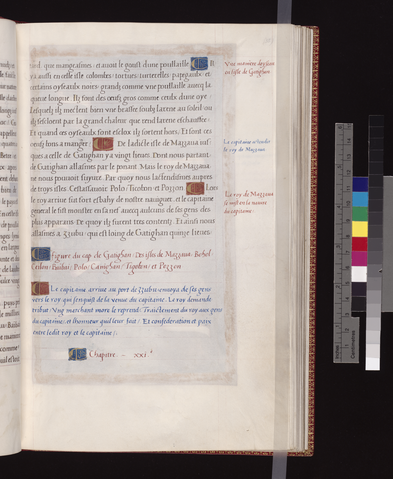
A page from Antonio Pigafetta’s logbook. This page contains records of the journey to and stay at the Camotes Islands (Central Philippines). Pigafetta’s detailed account serves as a valuable primary source, documenting important events and discoveries during Magellan’s circumnavigation. By Antonio Pigafetta
Pigafetta’s record is notable for its technical details on navigation and astronomical observations, observations of geography, flora, fauna, and climate of unknown lands, descriptions of interactions with local peoples and their languages, and insights into Magellan’s character and decision-making processes. Without this record, understanding the true significance and impact of Magellan’s voyage would have been much more difficult.
Historical Background and Motivation for the Voyage
Geographical Knowledge in 16th Century Europe
In the early 16th century, European knowledge of world geography was very limited. While the existence of the New World had been known since Columbus’s arrival in the Americas (1492), its full extent remained a mystery. The spread of North and South America, the existence and size of the Pacific Ocean, and the possibility of a western route to Asia were major questions for Europeans of the time.
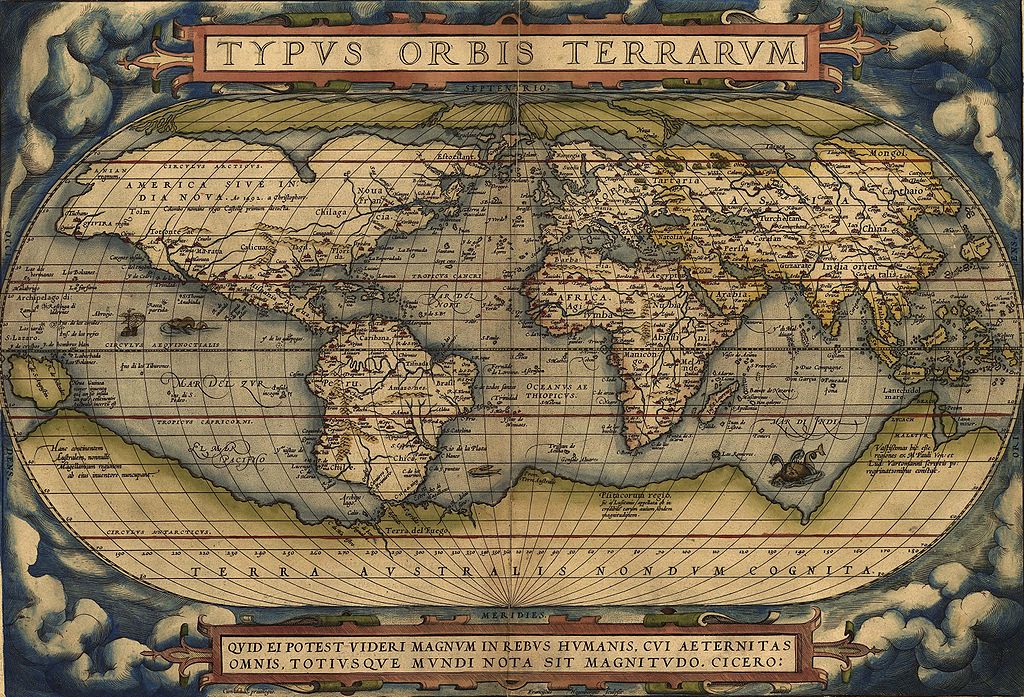
World map by Abraham Ortelius, 1570. This map shows the world as understood about 50 years after Magellan’s voyage. By Abraham Ortelius
Support from Spain
Magellan initially proposed his voyage to his home country, Portugal, but was rejected. Portugal had already established an eastern route via the Cape of Good Hope and didn’t feel the need for a new route. Additionally, Magellan’s plan could have potentially violated the Treaty of Tordesillas (1494) between Portugal and Spain.
Magellan then presented his plan to King Charles I of Spain (later Holy Roman Emperor Charles V). Spain supported Magellan’s plan for several reasons: they wanted to establish a new route to the Spice Islands (Moluccas) to break Portugal’s monopoly, the discovery of a new route could expand Spanish territory and influence, and Magellan’s nautical skills and experience were expected to enhance Spain’s naval capabilities.
Thus, Magellan set out to circumnavigate the globe under the Spanish flag.
Magellan’s World Circumnavigation Plan
On September 20, 1519, Magellan departed from the port of Sanlúcar de Barrameda, Spain, leading a fleet of five ships. His goal was to reach the Spice Islands (now part of Indonesia) via a western route. This plan was set against the backdrop of the colonial race among European powers and the quest for more efficient trade routes.
Magellan’s route selection reflected several innovative ideas. First, he held the understanding that the Earth was spherical, which was a progressive notion for the time. Furthermore, he hypothesized the existence of a strait at the southern end of South America. This hypothesis led to the important discovery of what would later be known as the Strait of Magellan.
Innovations in Navigation Technology
Astronomical Observation Techniques
Magellan’s voyage employed the latest astronomical observation techniques of the time. Particularly important was the astrolabe, an instrument for celestial observation. This allowed for determining the ship’s position and maintaining an accurate course. Pigafetta’s records detail methods for measuring celestial altitudes and calculating latitude.

An astrolabe similar to those used in the 16th century. Such instruments were used for astronomical observations during Magellan’s voyage. Whipple Museum of the History of Science, CC BY-SA 2.0
They also used a simple measuring tool called a cross-staff, which could determine approximate latitude by measuring the altitude of the North Star.
However, measuring longitude remained challenging and was one of the major difficulties during the voyage. The reasons for this difficulty were the need for accurate time measurement when precise portable timepieces (chronometers) didn’t exist, environmental factors like ship motion, temperature changes, and humidity greatly affecting the accuracy of existing clocks, and the lack of established methods to accurately understand and calculate the relationship between Earth’s rotation speed and longitude. This problem wasn’t solved until the 18th century when John Harrison invented a precise chronometer usable at sea.
Creation and Updating of Nautical Charts
During the voyage, Magellan’s fleet constantly created new nautical charts and updated existing maps. Pigafetta’s journal contains detailed records of unknown coastlines, island shapes, water depths, and currents. This information became invaluable resources for later navigators.
Notably, the discovery of the Strait of Magellan and its detailed mapping opened a new route to the Pacific Ocean, dramatically changing the concept of world maps.
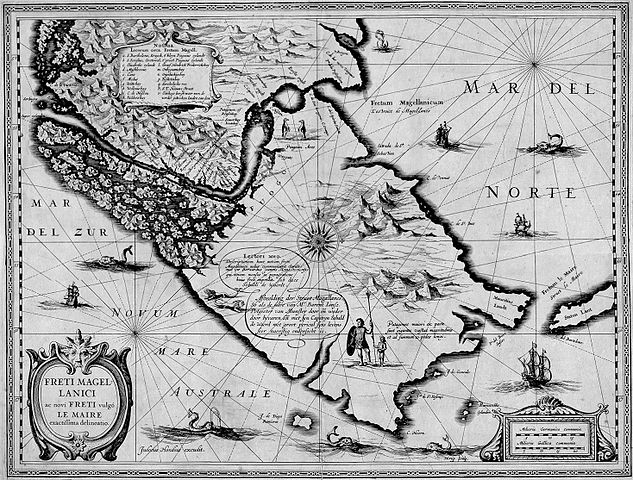
Map of the Strait of Magellan and Le Maire Strait by Jodocus Hondius, circa 1630. Created about 100 years after Magellan’s discovery, this map reflects detailed geographical information obtained through subsequent explorations, demonstrating the progress in 17th-century navigation techniques and cartography. By Jodocus Hondius I
Survival Strategies in Unknown Waters
Securing Food and Water
One of the biggest challenges in long-distance voyages was securing food and water. According to Pigafetta’s records, the ships were loaded with large quantities of hardtack, salted meat, and wine. However, as the voyage extended, these supplies began to run out.
Magellan developed strategies to replenish food and water at ports of call. They also frequently caught fish and seabirds for food. Particularly during the Pacific crossing, food shortages became severe, and crew members were reduced to boiling leather goods for sustenance.
Dealing with Diseases
Scurvy was a major problem in long voyages. This disease is caused by vitamin C deficiency. Magellan’s fleet was no exception, with many crew members suffering from this illness. Pigafetta’s records vividly describe the condition of crew members suffering from scurvy.
Magellan tried to address this problem by replenishing fresh fruits and vegetables whenever possible. They also discovered that drinking lemon juice could alleviate symptoms. These experiences became valuable lessons for later navigators.
Interactions with Indigenous Peoples
Encounters in Patagonia
In the Patagonia region of South America, Magellan’s crew encountered local indigenous people. Pigafetta’s records contain detailed descriptions of their appearance, customs, and language. Particularly intriguing are the descriptions of the Patagonians’ large stature, which later became the basis for the “Patagonian giants” legend.
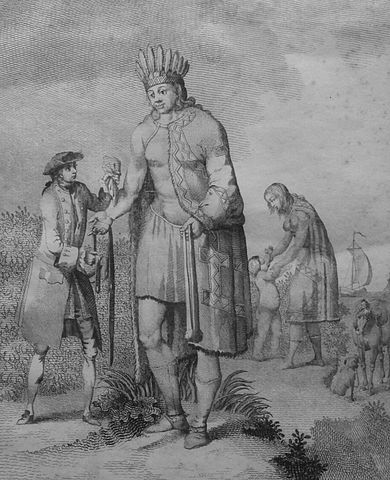
An 18th-century imaginary depiction of Patagonian ‘giants’. This legend, based on accounts from Magellan’s voyage, long stimulated European imagination. By Museo Histórico Nacional de Argentina
This “Patagonian giants” legend had a significant impact on European worldviews. It stimulated curiosity about unknown lands and fueled exploration fever, leading many Europeans to imagine what other wonders might exist in the world. It also deepened recognition of human diversity, contributing to the later development of anthropology and ethnology.
Furthermore, it influenced literature and art, becoming the subject of many creative works. For example, it’s said to have influenced Jonathan Swift’s “Gulliver’s Travels”.
However, this legend contained exaggerations and misunderstandings, and when later explorers actually visited Patagonia, no “giants” were found. This serves as an example of the challenges in reliability and interpretation of information about unknown worlds.
Events in the Philippines
In March 1521, Magellan’s fleet reached the Philippine Islands. The events here became a turning point in the voyage. Magellan attempted to establish friendly relations with local chiefs while also trying to spread Christianity.
However, on April 27, Magellan lost his life in a battle with Chief Lapu-Lapu on the island of Mactan. Pigafetta’s record contains a detailed description of this battle, vividly conveying Magellan’s final moments.
This event became symbolic of the complexities of contact between Europeans and non-European worlds. The fact that the voyage continued and eventually achieved circumnavigation after Magellan’s death testifies to the strength of his vision.
Impact and Significance of the Voyage
Magellan’s voyage fundamentally changed the concept of world maps. Particularly, the first recognition of the Pacific Ocean’s vastness had a huge impact on the geography of the time. Pigafetta’s records state that crossing the Pacific took over three months, far exceeding expectations of the time.
Moreover, this voyage became an opportunity to more accurately grasp the size of the Earth. The record of time and distance required for circumnavigation became important data for calculating the Earth’s circumference.
In terms of navigation technology, the methods used and knowledge discovered during Magellan’s voyage greatly influenced later navigators. Especially, navigation techniques in unknown waters and survival strategies for long voyages greatly contributed to subsequent explorations in the Age of Discovery. Magellan’s experiences became valuable references for later navigators in planning routes and supply points, pioneering large-scale, long-term voyages of exploration.
In the field of celestial navigation, the observation techniques used by Magellan were further refined and became the basis for navigation until the longitude problem was solved in the 18th century. Simultaneously, the detailed nautical charts created during Magellan’s voyage became valuable resources for later navigators, greatly contributing to improving the accuracy of world maps.
Furthermore, Magellan’s voyage heralded the beginning of large-scale contact between European and non-European worlds. This can be seen as the early stages of the colonial era and globalization. Encounters with unknown regions and organisms stimulated the curiosity of European scientists, leading to the development of natural history and anthropology.
Commercially, the new route to the Spice Islands that Magellan aimed for later became the foundation of Spain’s Pacific trade routes, greatly influencing the formation of the world economy.
Modern Implications
Even more than 500 years after Magellan’s voyage, its influence is deeply rooted in our worldview and scientific technology. Let’s look at some specific impacts on modern society.
Navigation Technology and GPS
Modern GPS technology can be seen as a solution to the positioning challenges faced by Magellan and his crew. The longitude measurements that were difficult in Magellan’s time can now be done instantly using satellite technology. The development of this technology can be seen as the result of long-term efforts to address the challenges posed by Magellan’s voyage.
Global Logistics Systems
The routes pioneered by Magellan form the foundation of today’s global maritime transport networks. Large-scale international trade using container ships can be seen as an extension of the maritime trade routes that began in Magellan’s era. His voyage was a precursor to viewing the world as a single economic zone.
Development of Cultural Anthropology
The encounters with different cultures recorded during Magellan’s voyage became one of the origins of modern cultural anthropology. Today’s researchers approach the challenges of cross-cultural understanding that Magellan and his crew faced in a more scientific and systematic way. The development of this academic field stems from the cultural encounters that began in Magellan’s era.</p
Environmental Awareness
The recognition of Earth’s vastness and finiteness, first realized during Magellan’s voyage, underlies the thinking behind modern environmental protection movements. The perspective of viewing Earth as a closed system can be traced back to Magellan’s circumnavigation. This understanding forms the basis for addressing contemporary global environmental issues.
Influence on Space Exploration
Magellan’s spirit of exploring unknown seas has been carried forward into modern space exploration. NASA’s “Magellan” probe exploring Venus is a symbolic example of this. The spirit of challenging the unknown and seeking new discoveries, embodied by Magellan, continues in today’s space development efforts.
Model for International Cooperation
Magellan’s voyage with a multinational team became a precursor to international cooperation seen in modern international scientific projects and space station operations. The attitude of people from different cultures and languages cooperating towards a common goal is essential in today’s global society.
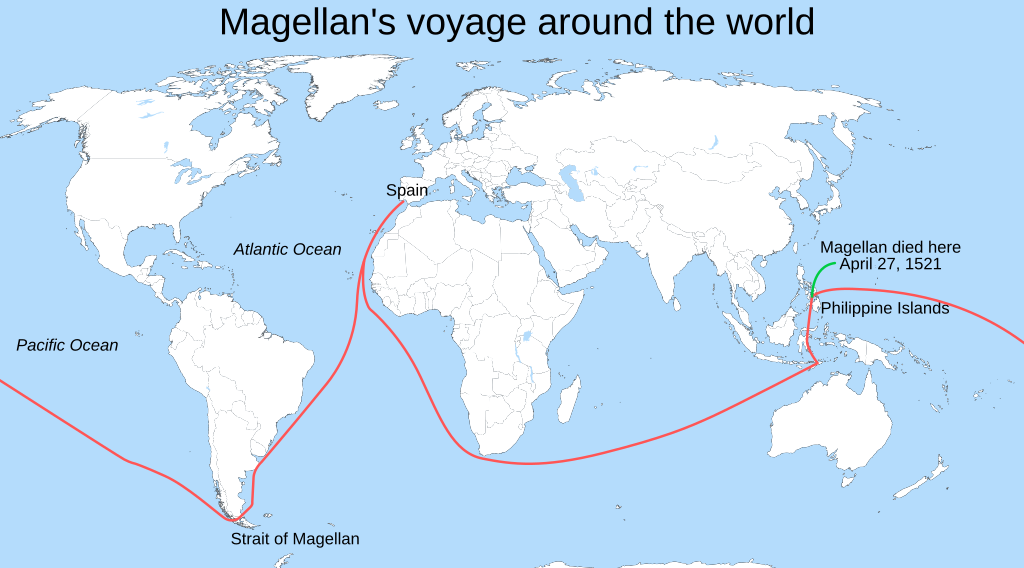
Map showing the route of Magellan’s circumnavigation of the world. This voyage dramatically changed human geographical understanding. MesserWoland and Petr Dlouhý, CC BY-SA 3.0
Conclusion
Although Ferdinand Magellan himself didn’t complete the circumnavigation of the world, his attempt is remembered as one of the most important events in human maritime history. The records of voyage participants, especially Antonio Pigafetta, serve as valuable testimonies to the navigation techniques, geographical knowledge, and cross-cultural encounters of the time.
The innovative navigation techniques used in Magellan’s voyage, particularly astronomical observation methods and chart-making techniques, greatly contributed to the development of subsequent navigation technology. Moreover, the records of survival strategies in unknown waters and interactions with indigenous peoples became valuable lessons for later explorers.
The expansion of geographical knowledge and the transformation of worldviews brought about by this voyage laid the foundation for modern geography. At the same time, this voyage, as a symbolic event of the Age of Discovery, also heralded the beginning of globalization.
Magellan’s courage and foresight, along with Pigafetta’s efforts in recording the voyage, continue to provide us with many insights as an important chapter in the history of human intellectual pursuit. It can be said that modern global society and scientific technological developments are built upon the path pioneered by Magellan and his crew.
We have the responsibility to continue exploring unknown territories and paving the way for a better future, carrying the lessons learned from Magellan’s voyage in our hearts. The human curiosity and spirit of inquiry demonstrated by Magellan’s voyage will continue to lead us to new discoveries.
